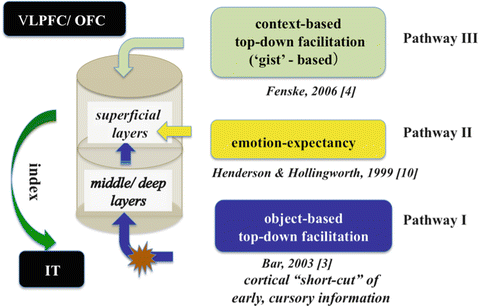Fig. 1
Three pathways in normal scene and object perception. The stars (red) indicate possible sites of conduction disturbance in VH. When disturbances occur, the PFC correctly receives contextual data and emotion/expectancy as in normal cognitive processes, but the quickly arriving short-cut data of an external object via Pathway I is missing. Bottom-up signals of external objects via V4/V2 are also missing for IT, caused by the second disturbances
OFC receives, among others, at least three streams of projections important in the present context: one is the low spatial frequency image (LFI) via a “cortical shortcut”, i.e., the magnocellular pathway from secondary visual systems (such as V2/V4) [3, 4]. The second and the third streams bring, respectively, “emotion and expectancy” from the OFC-ITC-amygdala triad [5] and contextual information as the “gist” of the scene, from the retrosplenial/parahippocampal cortices (RSC/PHC), which contribute to OFC processing by providing context-based top-down facilitation [4].
Hodological Dysfunction
We hypothesize that a conduction disturbancetemporarily occurs somewhere along Pathway I. We postulate that this might be caused primarily by the recently reported cortical degeneration of gray matter in the PFC and IT in hallucinating DLB patients [7], or loss of the α7 subtype of nicotinic receptors [6]. Because of these disturbances the PFC’s decision on categorical identity is made essentially on the basis of context and expectancy alone. Hence the PFC creates and sends “hallucinating” indices to IT.
There is another site of pathology, i.e., the IT cortex [7, 8]. The possible disconnection of IT from the secondary visual cortices V4/V2 due to conduction disturbances as above could be the second causative factor for VH (Fig. 1). This may block IT’s ability to compensate, based on detailed bottom-up data, potentially hallucinatory images induced by PFC (Fig. 2).


Fig. 2
PFC decision on top-down bias is based on three signals
The disconnections at the two sites could be regarded as an instance of dynamically fluctuating, and unidirectional hodological 1 deficiency [9].
4 Proposals: Root Cause for Visual Hallucinations Associated with DLB
1.




The root cause and the responsible areas: malfunction of PFC (VLPFC/OFC) and IT cortex. PFC sends a “hallucinatory” index of categorical identity on the basis of emotion-expectancy and the top-down context alone, ignoring external but cursory information via Pathway I.
Stay updated, free articles. Join our Telegram channel

Full access? Get Clinical Tree







